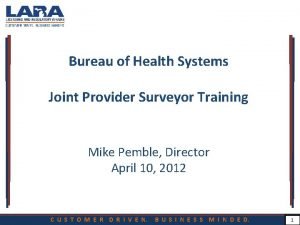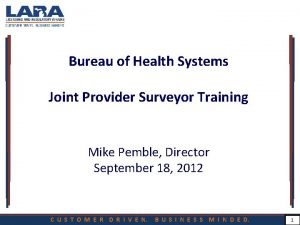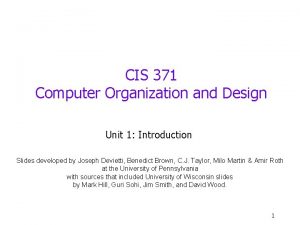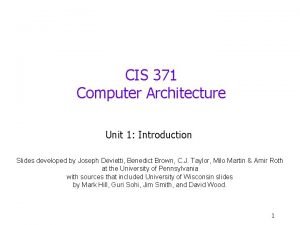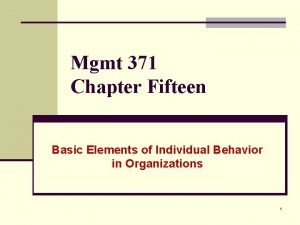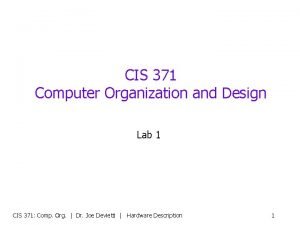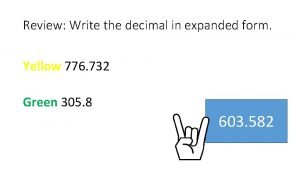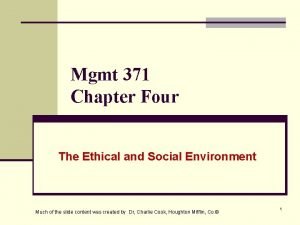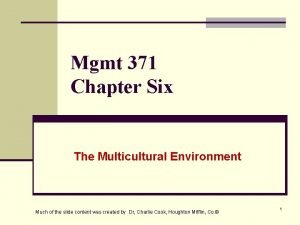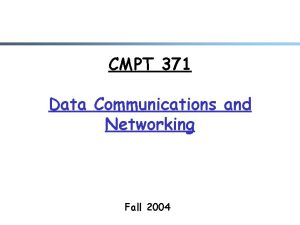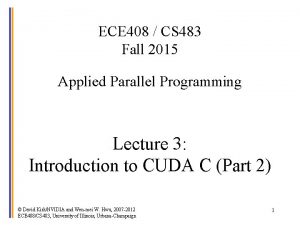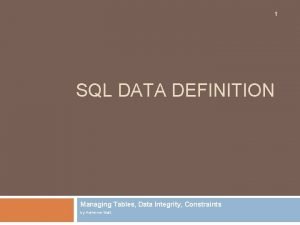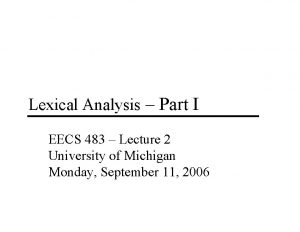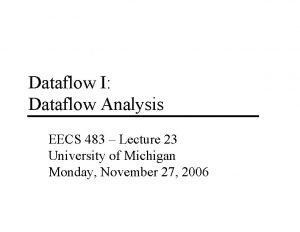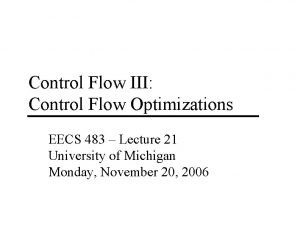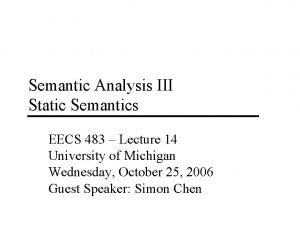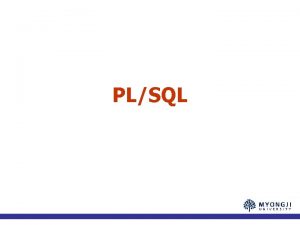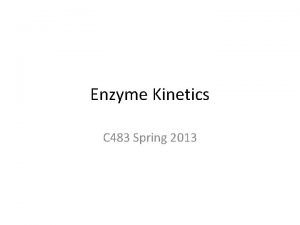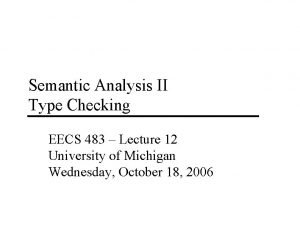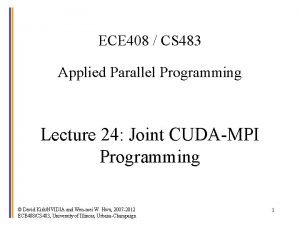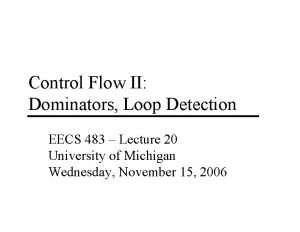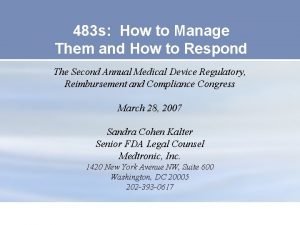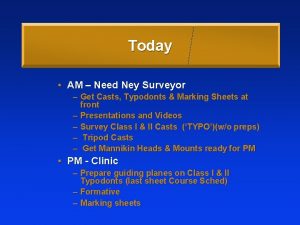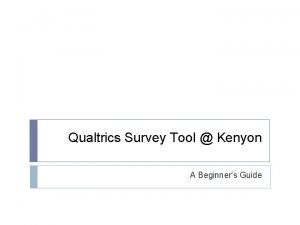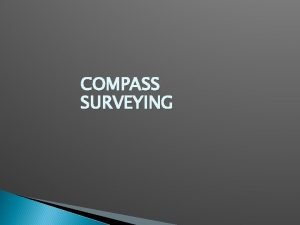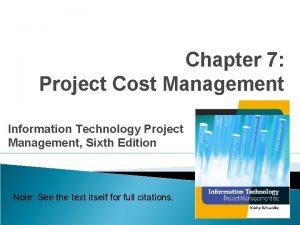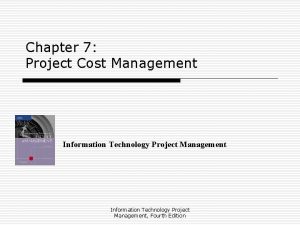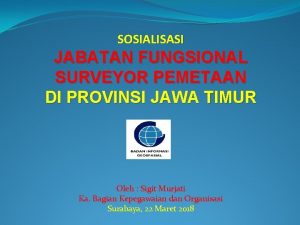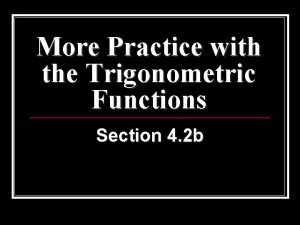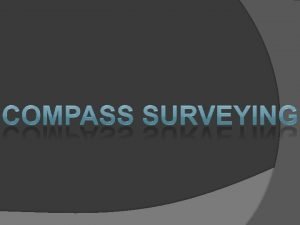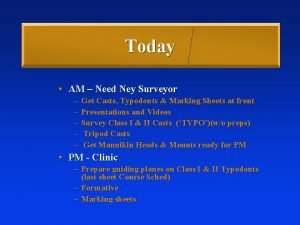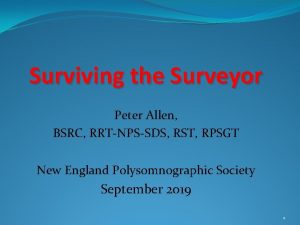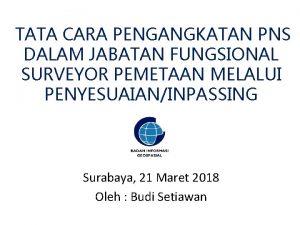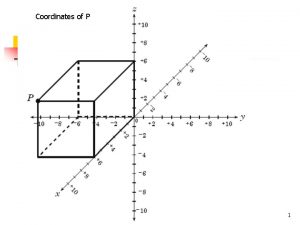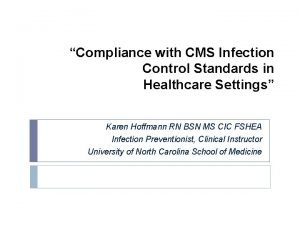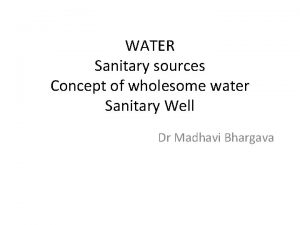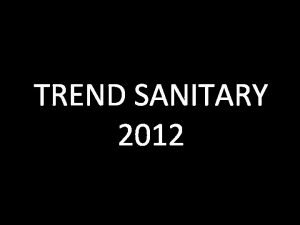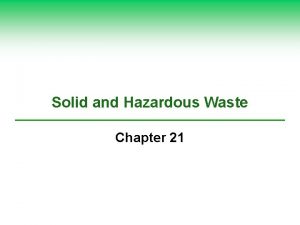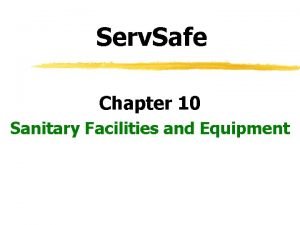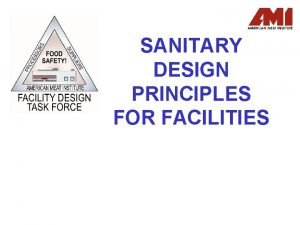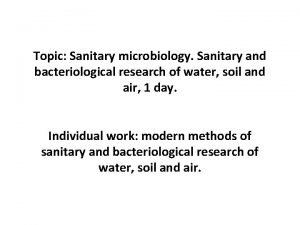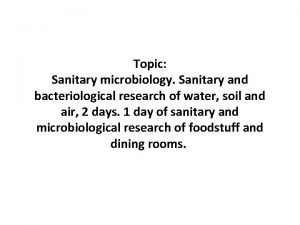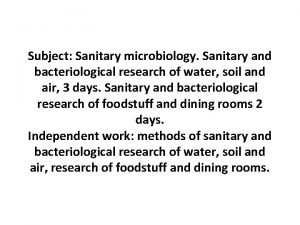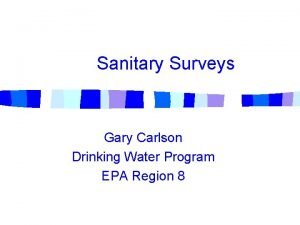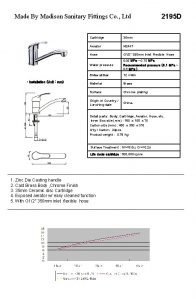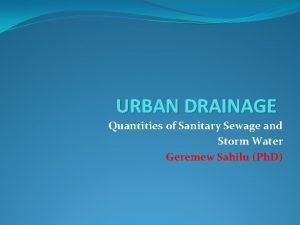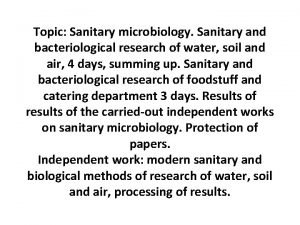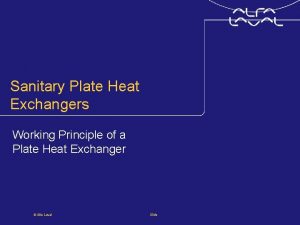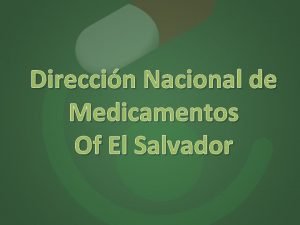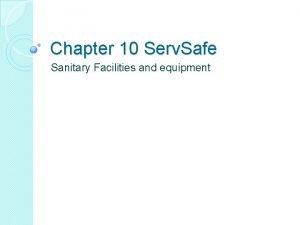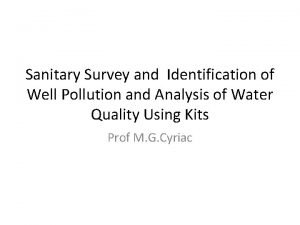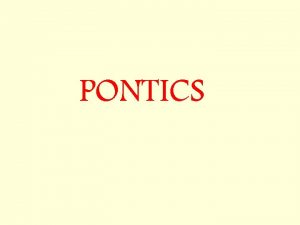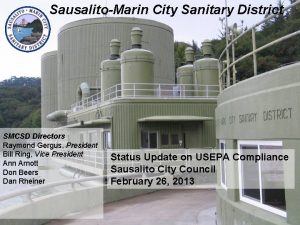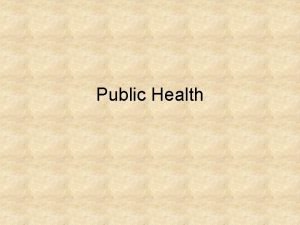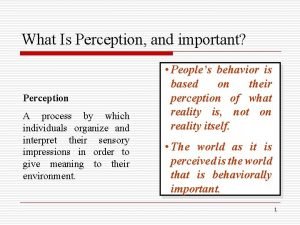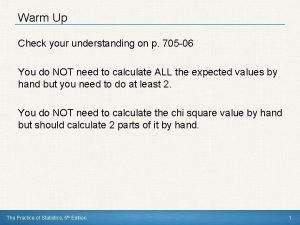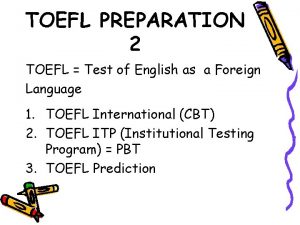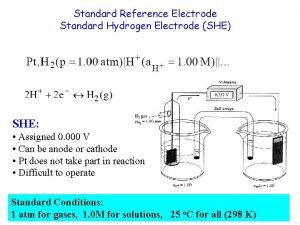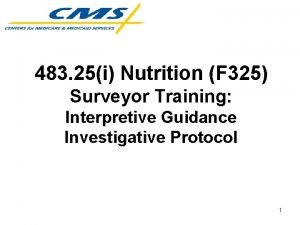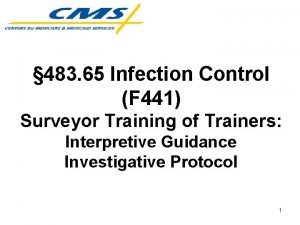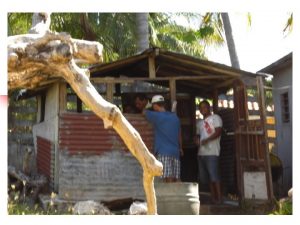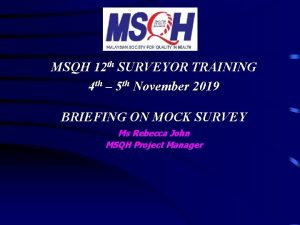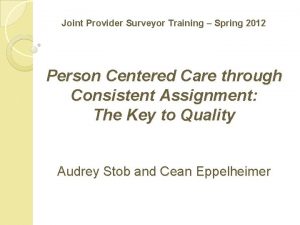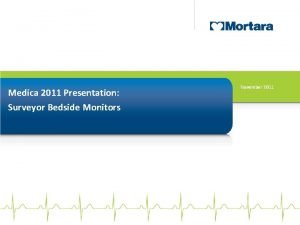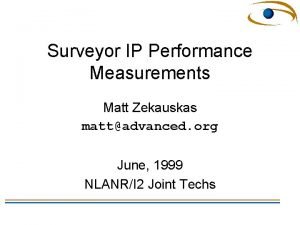483 35i Sanitary Conditions F 371 Surveyor Training























































































- Slides: 87

§ 483. 35(i) Sanitary Conditions (F 371) Surveyor Training: Interpretive Guidance Investigative Protocol 1

With regard to the revised guidance F 371 Sanitary Conditions, there have been significant changes. Specifically, F 370 and F 371 were merged. However, the regulatory language has remained the same. The revisions to F 371 were made to provide definition, education, explanation, and examples for the surveyors to reference. 2

Federal Regulatory Language The facility must — • § 483. 35(i)(1) Procure food from sources approved or considered satisfactory by Federal, State or local authorities; and • § 483. 35(i)(2) Store, prepare, distribute and serve food under sanitary conditions. 3

Intent The intent of this requirement is to ensure that the facility: • Obtains food for residents’ consumption from approved sources, and • Follows proper sanitation and food handling practices to prevent the outbreak of foodborne illnesses. 4

Training Objectives • Describe the relationship between the regulation and the interpretive guidance • Describe how to use the investigative protocol • Describe and apply components of the investigative protocol 5

Training Objectives (cont’d) • Identify areas of non-compliance with the sanitary conditions regulation • Appropriately categorize the scope and severity of noncompliance 6

Definitions • • • Cross-contamination Danger Zone Dry Storage Food Contamination Food Preparation Food Service/Distribution • Foodborne Illness • Highly Susceptible Population • Pathogen • Potentially Hazardous Food (PHF) • Ready-to-Eat Food • Storage • Toxins 7

Cross-contamination The transfer of harmful substances or diseasecausing microorganisms to food by hands, food contact surfaces, sponges, cloth towels, or utensils that are not cleaned after touching raw food, and then touch ready-to-eat foods. Cross-contamination can also occur when raw food touches or drips onto cooked or ready-to-eat foods. 8

Danger Zone Temperatures above 41 degrees Fahrenheit (F) and below 135 degrees F that allow the rapid growth of pathogenic microorganisms that can cause foodborne illness. Potentially Hazardous Foods or Time/Temperature Control for Safety foods held in the danger zone for more than 4 hours if being prepared from ingredients at ambient temperature, or 6 hours if cooked and cooled, may cause a foodborne illness if consumed. 9

Dry Storage Storing/maintaining dry foods (e. g. , canned goods, flour, sugar) and supplies (disposable dishware, napkins and kitchen cleaning supplies). Storage The retention of food (before and after preparation) and associated dry goods. 10

Food Contamination The unintended presence of potentially harmful substances, including but not limited to microorganisms, chemicals or physical objects in food. 11

Food Preparation The series of operational processes involved in getting foods ready for serving, such as: washing, thawing, mixing ingredients, cutting, slicing, diluting concentrates, cooking, pureeing, blending, cooling and reheating. 12

Foodborne Illness caused by the ingestion of contaminated food or beverages. 13

Food Service/Distribution The processes of getting food to the resident: • Holding foods hot on the steam table or under refrigeration for cold temperature control • Dispensing food portions for individual residents • Family style and dining room service • Delivering trays to residents’ rooms or units 14

Highly Susceptible Population Persons who are more likely than the general population to experience foodborne illness because of their susceptibility to becoming ill if they ingest microorganisms or toxins (e. g. , immunocompromised, chronic disease and advanced age). 15

Pathogen An organism capable of causing a disease (e. g. , pathogenic bacteria or viruses). 16

Potentially Hazardous Food (PHF or TCS) Food that requires time/temperature control for safety to limit the growth of pathogens or toxin formation 17

Ready-to-Eat Food that is edible with little or no preparation to achieve food safety. It includes foods requiring minimal preparation for palatability or culinary purposes, such as mixing with other ingredients (e. g. , tuna, chicken or egg salad). 18

Toxins Poisonous substances that are produced by living cells or organisms (e. g. , pathogenic bacteria) that cause foodborne illness when ingested. 19

Interpretive Guidance Overview • The risk of foodborne illness • Importance of effective food safety systems • Identification of hazards and Critical Control Points (CCPs) • Operational steps to eliminate hazards 20

Interpretive Guidance Types of Food Contamination • Biological • Chemical • Physical 21

Interpretive Guidance Biological Contamination • Most common types of disease producing organisms • Pathogenic bacteria, viruses, toxins, and spores contaminate food • Parasites 22

Interpretive Guidance Pathogenic Bacteria • Non-harmful vs. harmful bacteria • Food storage and preparation 23

Interpretive Guidance Factors Influencing Bacterial Growth • • Hazardous nature of the food Acidity (p. H) of the food Water percent of the food Time and temperature control of the food 24

Interpretive Guidance Viruses • Require a host for reproduction • Examples: – Hepatitis A – Norovirus (formerly known as Norwalk virus) 25

Interpretive Guidance Toxins • Origin – Staphylococcus aureus – Clostridium botulinum • Poisonous substances • Variety of sources 26

Interpretive Guidance Spores • Origin • Reactivation and favorable conditions for growth • Temperature control 27

Interpretive Guidance Chemical Contamination • Cleaning supplies should be stored separately from food items. • The most common chemicals include but are not limited to glass cleaners, soaps, oven cleaners and insecticides. 28

Interpretive Guidance Chemical Contamination (cont’d) • An inadequately identified chemical inadvertently mistaken as a food product added to food can cause illness. 29

Interpretive Guidance Physical Contamination Foreign objects that may inadvertently enter food. Examples: • Hair • Fingernails • Pieces of glass 30

Interpretive Guidance Other Factors Implicated In Foodborne Illnesses • Poor personal hygiene • Inadequate cooking and improper holding temperatures • Contaminated equipment • Unsafe food sources 31

Interpretive Guidance Surveying Facilities That Receive Food Prepared By Off-site Kitchens When a nursing home receives food services from an off-site location, the surveyor must assess whether the facility is compliant with 42 CFR 483. 35 (i). 32

Interpretive Guidance Culture Change Provisions • Family members or other resident guests who bring in food for the resident’s consumption are not regulated under this Federal tag. – Many State regulations address this issue. 33

Interpretive Guidance Pathogenic Microorganisms and Strategies for Their Control • Commonly identified ingestible items associated with illness-producing organisms • Primary agents of concern (hazards) are organisms associated with the food source • PHF/TCS primary control strategies to minimize potential for foodborne illness outbreak 34

Interpretive Guidance Source of Contamination Primary Agents of Concern PHF/TCS Primary Control Strategies Fruits and vegetables, fresh Cook to proper temperature Prevention of cross- contamination to ready-to-eat foods Ready-to-eat meat and poultry products Listeria monocytogenes Proper refrigeration during storage Pasteurized dairy products Listeria monocytogenes Proper refrigeration during storage Ice Norovirus Cleaning and sanitizing the internal components of the ice machine according to manufacturers’ guidelines E. coli O 157: H 7 Salmonella Norovirus Hepatitis A virus Shigella 35

Interpretive Guidance Source of Contamination Primary Agents of Concern PHF/TCS Primary Control Strategies Eggs, raw or unpasteurized Salmonella Cook to proper temperature Prevention of cross-contamination to ready-to-eat foods Poultry, raw Campylobacter Salmonella Clostridium perfringens Cook to proper temperature Prevention of cross-contamination to ready-to-eat foods Meat, raw E. coli 0157: H 7 Salmonella Campylobacter Clostridium perfringens Cook to proper temperature Prevention of cross-contamination to ready-to-eat foods Infectious food workers Norovirus Hepatitis A virus Shigella Salmonella Staphylococcus aureus Exclusion of infectious food workers Proper hand washing procedures Avoid bare-hand contact with readyto-eat foods 36

Interpretive Guidance Prevention of Foodborne Illness • • Food Handling and Preparation Employee Health Hand washing, Gloves, Antimicrobial Gel Hair Restraints/Jewelry/Nail Polish 37

Interpretive Guidance Safe Food Storage • Dry Food Storage should be maintained in a clean and dry area free of contaminants • Refrigerator Storage Safe Practices include: -Monitoring temperatures -Proper handling of hot food -Separation of raw animal foods and vegetables -Labeling, dating and monitoring foods 38

Interpretive Guidance Safe Food Preparation • • Cross-Contamination Thawing Final Cooking Temperatures Reheating Food 39

Interpretive Guidance Process Food Item Temperatures Final Cooking Temperatures Poultry and stuffed foods 165 degrees F Ground Meat 155 degrees F Fish and other meats 145 degrees F Unpasteurized eggs 145 degrees F Internal temperature 165 degrees F Intact package 135 degrees F Reheating foods 40

Interpretive Guidance Process Time Temperatures Cooling Within 2 hours From 135 degrees F to 70 degrees F Within 4 hours Cooled to 41 degrees F Total time cooling not to Cooled from 135 exceed 6 hours degrees F to 41 degrees F 41

Interpretive Guidance Prevention of Foodborne Illness • Cooling • Modified Consistency • Pooled Eggs 42

Interpretive Guidance Food Service and Distribution • Tray line, alternative meal preparation and service area • Food distribution • Snacks • Special events • Transported foods • Ice • Refrigeration 43

Interpretive Guidance Equipment and Utensil Cleaning and Sanitization • Machine Washing and Sanitizing • Manual Washing and Sanitizing • Cleaning Fixed Equipment 44

Interpretive Guidance Equipment and Utensil Cleaning and Sanitization (cont’d) Wiping Cloths • Service area wiping cloths are cleaned and dried, or • Placed in a chemical sanitizing solution of appropriate concentration. 45

Investigative Protocol Sanitary Conditions Use this protocol to investigate compliance at F 371 (483. 35(i) (1) and (2)). 46

Investigative Protocol Objectives • To determine if the facility procured food from approved sources • To determine if the facility stores, prepares, distributes, and serves food in a sanitary manner to prevent foodborne illness 47

Investigative Protocol Objectives (cont’d) To determine if the facility has systems (e. g. policies, procedures, training, and monitoring) in place to prevent the spread of foodborne illness and compromising of food safety 48

Investigative Protocol Objectives (cont’d) To determine if the facility utilizes safe food handling from the time the food is received from the vendor and throughout the food handling processes in the facility 49

Investigative Protocol Procedures • • Observations Interviews Record Reviews Review of Facility Practices 50

Investigative Protocol Observe Food Procurement Procedures • Observe when, where and how food is procured • Concurrently with the observations, review: – Invoices – Vendor records – Source verification 51

Investigative Protocol Observe Food Preparation Procedures • • Food handling practices Food labeling and dates Hand washing Handling of potential cross-contamination foods • Acceptable cooking and cooling temperatures 52

Investigative Protocol Observe Service of Food during Trayline Operations • Observe staff measuring the temperature of all hot and cold menu items • Cold foods should be at or below 41 degrees F • Hot foods should be at or above 135 degrees F 53

Investigative Protocol Observe Dish Room Operations • Observe whether staff are properly operating dish machine and evaluate sanitization processes • Check for proper equipment and supplies to evaluate dish machine operation • Observe three-step process of manual pot and pan washing 54

Investigative Protocol Observe Service of Food after Meal Times • Observe stored dishes, utensils, pots/pans, and equipment for evidence of soiling • Evaluate whether proper hand washing is occurring between handling soiled and clean dishes to prevent cross-contamination of the clean dishes 55

Investigative Protocol Observe Food Storage • Look for evidence of pests, rodents and droppings and other sources of contamination • Observe whether foods are labeled and dated • Observe whether foods are stored off of the floor 56

Investigative Protocol Observe Food Storage (cont’d) • Check for canned goods that have a compromised seal • Observe whether staff access bulk foods without touching the food 57

Investigative Protocol Interview During the course of the survey, interview multiple staff who perform the task, about the procedures they follow to procure, store, prepare, distribute and serve food to residents. 58

Investigative Protocol Record Reviews • Resident records • Dietary/kitchen policies and procedures • Maintenance records, such as work orders and manufacturer’s specifications, related to equipment used to store, prepare, and serve food • Facility infection control records 59

Investigative Protocol Review of Facility Practices Review facility documents and interview staff to establish if the facility has processes and practices to promote food safety and prevent the spread of foodborne illness. 60

42 CFR 483. 35(i) (1)(2) Sanitary Conditions DETERMINATION OF COMPLIANCE (Appendix P) 61

Determination of Compliance Did the facility: • Procure food from approved sources? • Properly store, prepare, distribute and serve foods for residents’ consumption? 62

Determination of Compliance Criteria for Compliance with F 371 The facility is in compliance if staff: • Procures, stores, handles, prepares, distributes, and serves food to minimize the risk of foodborne illness • Maintains PHF/TCS foods at safe temperatures, cools food rapidly, and prevents contamination during storage 63

Determination of Compliance Criteria for Compliance with F 371 (cont’d) The facility is in compliance if staff: • Cook food to the appropriate temperature and hold PHF/TCS foods cold or hot • Utilizes proper hand washing and personal hygiene practices to prevent food contamination • Maintains equipment and food contact surfaces to prevent food contamination 64

Determination of Compliance Noncompliance with F 371 May include, but is not limited to, one or more of the following, failure to: • Procure, store, handle, prepare, distribute, and serve food in accordance with the standards summarized in this guidance 65

Determination of Compliance Noncompliance with F 371 (cont’d) Failure to: • Maintain PHF/TCS foods at safe temperatures, at or below 41 degrees F (for cold foods) or at or above 135 degrees F (for hot foods) – Exception: during preparation, cooking, or cooling • Ensure that PHF/TCS food plated for transport was not out of temperature control for more than four hours. 66

Determination of Compliance Noncompliance with F 371 (cont’d) Failure to: • Store raw foods properly to reduce the risk of contamination of cooked or readyto-eat foods • Ensure that foods are cooked to the appropriate temperature and cooled properly to prevent foodborne illness 67

Additional Investigation Potential Tags for Additional Investigation 68

DEFICIENCY CATEGORIZATION (Part IV, Appendix P) 69

Severity Determination Key Components • Harm/negative outcome(s) or potential for negative outcomes due to a failure of care and services, • Degree of harm (actual or potential) related to noncompliance, and • Immediacy of correction required. 70

Severity Determination Determining Actual or Potential Harm Actual or potential harm/negative outcomes for F 371 may include: • Foodborne illness; or • Ingestion or potential ingestion of food that was not procured from approved sources, prepared, distributed or served under sanitary conditions. 71

Severity Determination Determining Degree of Harm How the facility practices caused, resulted in, allowed, or contributed to harm (actual/potential) • If harm has occurred, determine if the harm is at the level of serious injury, impairment, death, compromise, or discomfort; and • If harm has not yet occurred, determine how likely the potential is for serious injury, impairment, death, compromise or discomfort to occur to the resident. 72

Severity Determination Severity Level 4 Deficiency Categorization Immediate Jeopardy to Resident’s Health or Safety 73

Severity Determination Level 4 Immediate Jeopardy • Has allowed/caused/resulted in, or is likely to cause serious injury, harm, impairment, or death to a resident; and 74

Severity Determination Level 4 Immediate Jeopardy (cont’d) • Requires immediate correction, as the facility either created the situation or allowed the situation to continue by failing to implement preventative or corrective measures. 75

Severity Determination Level 4 Example • A roast thawing on a plate in the refrigerator had bloody juices overflowing and dripping onto uncovered salad greens on the shelf below. • The contaminated salad greens were not discarded and were used to make salad for the noon meal. 76

Severity Determination Level 4 Example • The facility had a recent outbreak of Norovirus as a result of a food worker experiencing episodes of vomiting and diarrhea, and the facility allowed the staff to continue preparing food. • Observations and interviews indicate that there are other food service staff experiencing gastrointestinal illnesses who are still permitted to prepare food. 77

Severity Determination Severity Level 3 Deficiency Categorization Actual Harm that is not Immediate Jeopardy The negative outcome may include but may not be limited to clinical compromise, decline, or the resident’s inability to maintain and/or reach his/her highest practicable level of well-being. 78

Severity Determination Level 3 Example An outbreak of nausea and vomiting occurs in the facility related to the inadequate sanitizing of dishes and utensils. 79

Severity Determination Level 3 Example A mild episode of food poisoning occurred because the facility had a special event in which tuna, chicken, and potato salads served in bulk were not kept adequately chilled and were left out for eating after 5 hours. 80

Severity Determination Severity Level 2 Deficiency Categorization No Actual Harm with potential for more than minimal harm that is not Immediate Jeopardy 81

Level 2 Deficiency Categorization • Noncompliance that results in a resident outcome of no more than minimal discomfort, and/or • Has the potential to compromise the resident's ability to maintain or reach his or her highest practicable level of well-being. 82

Severity Determination Level 2 Example • Food service workers sliced roast pork on the meat slicer. • The meat slicer was not washed, rinsed, and sanitized after usage. • During the dietary service system assessment, two days later, the surveyor observed the meat slicer soiled with dried meat underneath the blade. • The facility failed to educate and train staff on how to clean and sanitize all kitchen equipment. 83

Severity Determination Level 2 Example • During the tour of the kitchen, two food service workers were observed on the loading dock. • One was smoking and the other employee was emptying trash. • Upon returning to the kitchen, they proceeded to prepare food without washing their hands. 84

Severity Level 1 Deficiency Categorization No Actual Harm with Potential for Minimal Harm 85

Level 1 Deficiency Categorization The failure of the facility to procure, prepare, store, distribute and handle food under sanitary conditions places this highly susceptible population at risk for more than minimal harm. Therefore, Severity Level 1 does not apply for this regulatory requirement. 86

Questions? 87
 Joint provider surveyor training michigan
Joint provider surveyor training michigan Joint provider surveyor training michigan
Joint provider surveyor training michigan Airworthiness surveyor courses
Airworthiness surveyor courses Cis 371
Cis 371 Cis 371
Cis 371 Mgmt 371
Mgmt 371 387 hangi onluğa yuvarlanır
387 hangi onluğa yuvarlanır Cis371
Cis371 305 in word form
305 in word form Mgmt 371
Mgmt 371 Cmpt 371
Cmpt 371 Mgmt 371 final exam
Mgmt 371 final exam 6 371
6 371 Top dop
Top dop Ley notarial bolivia
Ley notarial bolivia Ece 408 uiuc
Ece 408 uiuc Biba n 483 ddl
Biba n 483 ddl Eecs 483 umich
Eecs 483 umich Eecs483
Eecs483 Sebuah lampu natrium 20 watt berwarna kuning
Sebuah lampu natrium 20 watt berwarna kuning Eecs 483
Eecs 483 483 ley
483 ley Ley 483
Ley 483 Eecs 483
Eecs 483 2 147 483
2 147 483 Eecs 483
Eecs 483 Kcat
Kcat Eecs 483
Eecs 483 Documentos protocolares
Documentos protocolares Cs 483
Cs 483 Dominate
Dominate Fda 483 response cover letter
Fda 483 response cover letter Height of contour of tooth
Height of contour of tooth Land surveyor kenyon
Land surveyor kenyon Picarro surveyor
Picarro surveyor Recording relation of cast to surveyor
Recording relation of cast to surveyor Prismatic compass and surveyor compass
Prismatic compass and surveyor compass Project cost breakdown
Project cost breakdown Cost estimation table
Cost estimation table Surveyor pemetaan ahli pertama
Surveyor pemetaan ahli pertama Army accreditation matrix
Army accreditation matrix Kirsten places her surveyor's telescope
Kirsten places her surveyor's telescope Chain and compass survey
Chain and compass survey Azumith
Azumith Get ney
Get ney Quantity surveyor course in hyderabad
Quantity surveyor course in hyderabad Peter allen surveyor
Peter allen surveyor Jabatan fungsional surveyor pemetaan
Jabatan fungsional surveyor pemetaan To find the height of a pole a surveyor moves 140
To find the height of a pole a surveyor moves 140 Infection control surveyor worksheet
Infection control surveyor worksheet Define the term safe and wholesome water
Define the term safe and wholesome water Trend sanitary
Trend sanitary Sanitary landfill
Sanitary landfill In keeping equipment and facilities safe and sanitary
In keeping equipment and facilities safe and sanitary Sanitary supplies wholesaler
Sanitary supplies wholesaler 10 principles of sanitary design
10 principles of sanitary design Las gallinas valley sanitary district
Las gallinas valley sanitary district Abutment pontic retainer
Abutment pontic retainer Sanitary microbiology
Sanitary microbiology Microbiology
Microbiology Sanitary microbiology
Sanitary microbiology Epa sanitary survey
Epa sanitary survey Castelli sanitary
Castelli sanitary Estimation of sewage flow and storm water drainage
Estimation of sewage flow and storm water drainage Sanitary microbiology
Sanitary microbiology Sanitary plate
Sanitary plate Sanitary registration in el salvador
Sanitary registration in el salvador Sanitary facilities and equipment
Sanitary facilities and equipment Sanitary survey
Sanitary survey Pontic
Pontic Sanitary landfill
Sanitary landfill What is visual pollution definition
What is visual pollution definition Pasco sanitary landfill
Pasco sanitary landfill Sausalito marin city sanitary district
Sausalito marin city sanitary district The sanitary report 1842 bbc bitesize
The sanitary report 1842 bbc bitesize Training is expensive without training it is more expensive
Training is expensive without training it is more expensive Perbedaan on the job training dan off the job training
Perbedaan on the job training dan off the job training Aggression replacement training facilitator training
Aggression replacement training facilitator training Biological conditions are irrelevant to ego states
Biological conditions are irrelevant to ego states Name of weather conditions
Name of weather conditions What causes warm air to rise brainpop
What causes warm air to rise brainpop Conditions for chi-square test
Conditions for chi-square test Skill 6: listen for who and what with multiple nouns
Skill 6: listen for who and what with multiple nouns Describe the conditions under which new species may arise.
Describe the conditions under which new species may arise. Tasks conditions and standards
Tasks conditions and standards She conditions
She conditions 6 driving conditions
6 driving conditions Decision making conditions
Decision making conditions
